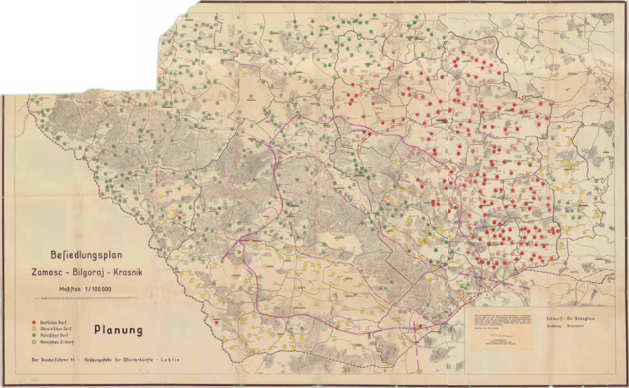German peasant soldier colony
Reichskommissar Himmler puts SS and Polizeiführer Globocnik of Lublin District in charge of the Germanic colonization project in the region around Zamosc, currently in south-eastern Poland. After the Jews had been deported, some 110,000 Poles and Ukrainians in 294 villages are arrested and racially selected between November 1942 and August 1943. Children under the age of 14 and people over 60 are left to their own devices. Young children with ‘Germanic characteristics’ are sent to foster homes in Germany to undergo Germanization. Adults are crammed into wagons and deported to Berlin to relieve Jewish forced laborers, who may now depart for Auschwitz. Ethnic German peasant soldiers and their families are provided with furnished farms including household items and cattle in the more affluent villages (red). Collaborating Polish and Ukrainian farmers are housed in neighbouring Z-villages (pink). In the redbordered area that contains many endangered Polish (green) and Ukrainian (yellow) villages, a partisan battle rages. At the same time, Globocnik leads the Aktion Reinhardt that entails the murder of 1.7 million Jews and 50,000 Roma in the Majdanek, Bełżec, Sobibór and Treblinka extermination camps – also aided by special maps.

F. Staglica & Steinmetz, Besiedlungsplan Zamosc - Bilgorai - Krasnik, (Settlement Aplan Zamosc - Biłgoraj – Krasnik) Lublin 1943, (21-7 signed by cient Odilo Globocnik). Digital print, Bundesarchiv Berlin, 92,5 x 151 cm.
